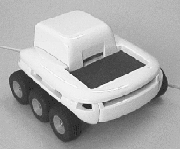 My Robot Friends
My Robot Friends My Robot Friends
My Robot Friends |
Cyclopes: My experience in mobile robotics started with these two robots. They were both equipped with a HC11 microcontroller that was programmed in assembler. Programming these beasts in assembler was definitely a lot of fun. The goal of the project was to have the left robot use its three linear cameras to follow the right robot on its side. |
 |
My real research started with this robot: the autonomous vacuum cleaner. This project was my undergraduate thesis at the EPFL. For more information about this robot, check out the corresponding journal paper. |
 |
Koala: The autonomous vacuum cleaner robot was based on the prototype of this robot. Obviously, this brandnew robot looks much better than the prototype, although it doesn't vacuum... For more information about this robot, check out the web pages of the K-Team. |
 |
The Khepera is a very small mobile robot. The scale next to the robot is in cm and not in inches. This pretty famous robot is actually the predecessor of the Koala robot. Over the last few years, it has been sold several hundred times to many research institutes. For more information, check out the K-Team. |
 |
In 1987, the UM Mobile Robotics Laboratory was created with the acquisition of Carmel. Carmel has had quite a past, serving as a platform for the development of VFH and other methods. In 1992, Carmel won the Mobile Robot Olympics in San Jose, and also received a "Best of What's New" award from Popular Science. During my time in Michigan, Carmel was still booted up once in a while for demonstrations of its obstacle avoidance performance. |
 |
Andros: Cool but rather noisy robot. It can move the outer four wheels up and down so that the robot can actually stand up. It supposedly is capable of dealing with stairs, but I wouldn't want to be near it. |
 |
While the former two robots were great legacies, most of my friends at the lab worked with TRC Labmate robots. |
 |
A fancy photograph of the obstacle avoidance demonstration. It's hard to see, but the robot avoids several thin poles. |
 |
This is CLAPPER, which stands for Compliant Linkage Autonomous Platform with Position Error Correction. This robot was built at the UM lab, based on two TRC Labmate robots. Through a clever algorithm, the odometry information from the two trucks can be combined to detect and correct odometry errors. |
 |
This is where I finally enter the picture. My first task at the UM was to develop an interface for 32 ultrasonic sensors. The sonars and the EERUF board were then mounted on CLAPPER as shown in the image. |
 |
OmniMate is the successor of Clapper. OmniMate is basically the same robot, with the difference that it is commercially available, built by TRC, nicer looking, and less cables are hanging around. |
 |
The GuideCane was my Master's Thesis. The device is a navigation aid for visually impaired people. It is based on obstacle avoidance technology originally developed for mobile robots. Not only was the GuideCane a great project to work on, but it was also in the news world-wide and won the 1998 Discover Magazine award in Robotics |